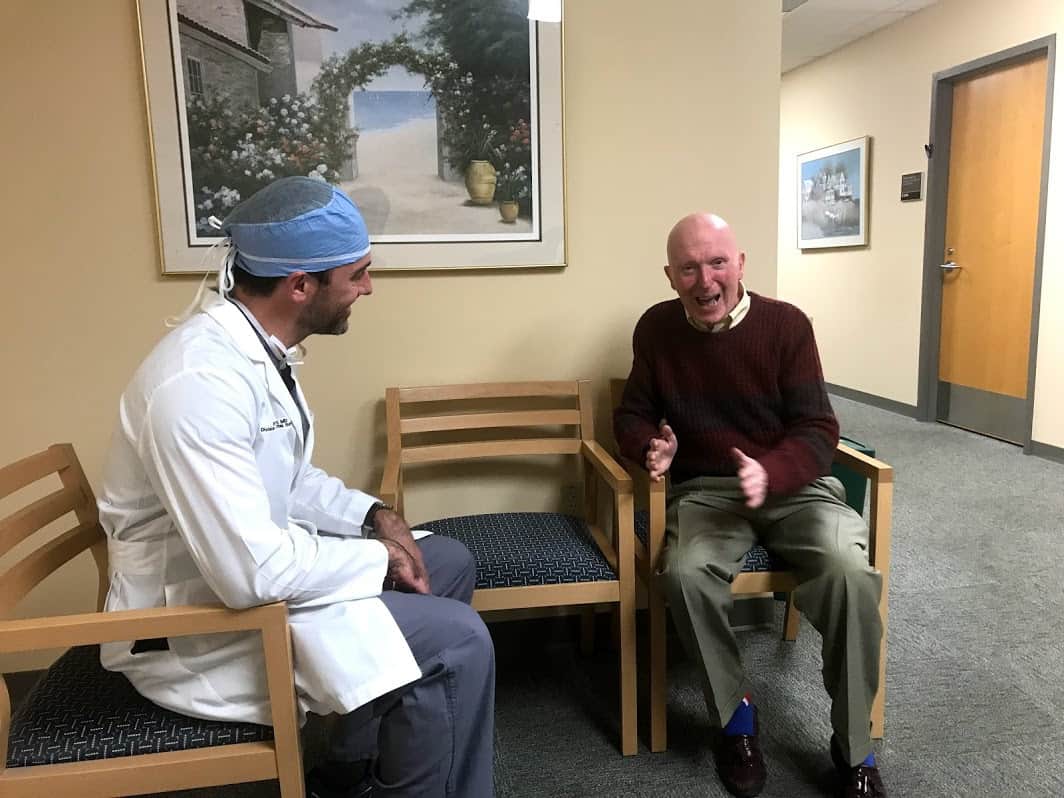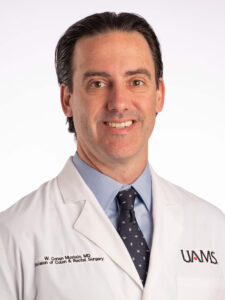UAMS Colorectal Surgeon: Know the Symptoms and Your Surgeon
|
Most colorectal cancers occur in the colon, the abdominal portion of the large intestine, but up to a third of cases arise in the last 6-8 inches of the bowel, known as the rectum. While more challenging to treat than colon cancer, rectal cancers often display symptoms at an earlier stage, causing bleeding or discomfort.
“Patients will generally suspect something is wrong,” said Conan Mustain, M.D., an assistant professor in the UAMS College of Medicine who sees patients in the UAMS Winthrop P. Rockefeller Cancer Institute. “Many times patients will attribute their symptoms to hemorrhoids.”
Keith Maddison says that was the case for him. As a former education specialist for the Arkansas Regional Organ Recovery Agency (ARORA), Maddison spent decades educating Arkansans about the importance of organ and tissue donation.
Stress was no stranger to Maddison. So when he noticed blood in his stool, he attributed it to pressures of his job and everyday life.
“I’d had symptoms for a while,” Maddison said. “Though it was never a lot. And I never had any pain. I’d think to myself that it may be a hemorrhoid or an ulcer and thought I just needed to slow down.”
Maddison ended up resigning from his job at ARORA after 26 years. But the symptoms continued. A relative, visiting from England, pushed him to schedule a colonoscopy.
“He jumped on me big time,” Maddison said. “He told me his dad died of colon cancer 20 years ago. So I decided I should get screened.”
When he woke up from his colonoscopy, the doctor confirmed that it was cancer.
“On the drive home from the clinic, I thought about how I’d have a general surgeon at one location and then go to another location for treatment,” Maddison said. “I wanted to go to UAMS because I felt like all the doctors would get together and talk about what’s going on with me. And that’s exactly what happened.”
Colorectal cancer cases at UAMS are discussed weekly by a multi-disciplinary team that includes colorectal surgeons, surgical oncologists, pathologists, radiologists, medical oncologists and radiation oncologists. The health care professionals make sure they have the best plan mapped out for each patient. Before the tumor was removed, Maddison was treated with chemotherapy and radiation. Maddison says he wasn’t worried about hair loss. He’d been shaving his head for years.
“Some of the staff members thought I’d already started chemo because of my bald head,” Maddison said with a smile.
The chemotherapy treatments helped to shrink the tumor and decrease the chance that any would be left behind after his procedure.
“The tumor shrank tremendously,” Mustain said. “We did a robotic surgery and were able to go in through very small incisions in the abdomen.”
Like all the surgeons who perform colon and rectal surgery at UAMS, Mustain is board certified — meaning, in addition to general surgery, he has had additional training specifically in colon and rectal cancer and other diseases that affect the large intestine.
Maddison was happy to have a surgeon with that expertise because the risk of having a permanent colostomy is higher when rectal cancer surgery is done by inexperienced surgeons in low-volume centers. Surgeons who are specially trained are able to use techniques to safely remove the tumor and bring healthy intestine down for a functional bowel, even for low tumors close to the opening. Unfortunately, the majority of rectal cancers in the United States are treated in hospitals that see fewer than 20 cases per year and many surgeons do not even offer the chance to have the intestine reconnected. Not surprisingly, the permanent colostomy rate for rectal cancer in the U.S. is close to 50%.
“Those are stats we’d like to see change,” Mustain said. “We know the outcomes are better when patients are operated on by surgeons at centers that do a lot of these procedures.”
Maddison underwent a successful removal of his tumor with reconnection and had only a temporary protective ileostomy (an artificial opening in the abdomen wall made from the small intestine), while he finished a few months of additional chemotherapy. Once chemotherapy was finished Mustain performed a minor procedure to close the stoma and restore normal digestive function.
“It was like a parasite that I had to carry around with me,” he said. “Then I decided to name it. Once I did that, I was able to deal with it better. In fact, I was a little emotional when I got ready for the reversal. I know it’s weird, but I’d sort of grown attached to it.”
Maddison soon lost that attachment and is thankful for the entire team that made it possible. Today he enjoys fishing and working towards personal records in the gym where he often works out alongside Mustain. His most recent CT scans showed that he is still in remission, two years past his diagnosis.

